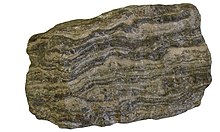

Foliation in geology refers to repetitive layering in metamorphic rocks.[1] Each layer can be as thin as a sheet of paper, or over a meter in thickness.[1] The word comes from the Latin folium, meaning "leaf", and refers to the sheet-like planar structure.[1] It is caused by shearing forces (pressures pushing different sections of the rock in different directions), or differential pressure (higher pressure from one direction than in others). The layers form parallel to the direction of the shear, or perpendicular to the direction of higher pressure. Nonfoliated metamorphic rocks are typically formed in the absence of significant differential pressure or shear.[1] Foliation is common in rocks affected by the regional metamorphic compression typical of areas of mountain belt formation (orogenic belts).
More technically, foliation is any penetrative planar fabric present in metamorphic rocks. Rocks exhibiting foliation include the standard sequence formed by the prograde metamorphism of mudrocks; slate, phyllite, schist and gneiss. The slatey cleavage typical of slate is due to the preferred orientation of microscopic phyllosilicate crystals. In gneiss, the foliation is more typically represented by compositional banding due to segregation of mineral phases. Foliated rock is also known as S-tectonite in sheared rock masses.
Examples include the bands in gneiss (gneissic banding), a preferred orientation of planar large mica flakes in schist (schistosity), the preferred orientation of small mica flakes in phyllite (with its planes having a silky sheen, called phylitic luster – the Greek word, phyllon, also means "leaf"), the extremely fine grained preferred orientation of clay flakes in slate (called "slaty cleavage"), and the layers of flattened, smeared, pancake-like clasts in metaconglomerate.[1]